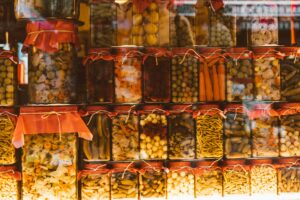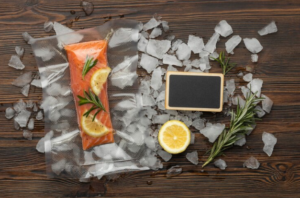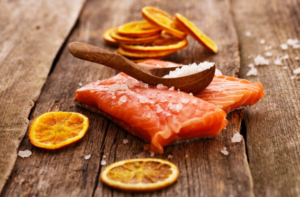If you did not know this, a single salmon can eat up to 2% of its body weight per day. This implies that if a person weighs 150 pounds, they can eat three pounds of food each day!
Among the ocean’s most captivating fish feeders, it is interesting to note that salmon go through huge shifts in their diet as they grow up. For the last few years I have dedicated to studies of these splendid fishes and I look forward to describing all you need to know about salmon feeding behavior.
From there, we will follow their progression from freshwater eggs to fry to ocean-based adults and return to this wonderful strategy of salmon nutrition.

1. Salmon Diet Through Different Life Stages
Early Freshwater Stage Diet (Alevin and Fry)
Very early on in the lifecycle, salmon start off as alevin and come from gravel nests, with their embryonic body measure held in the yolk. When they change into fry, they are free to move into the open water environment and start grazing on small animals like zooplankton and aquatic insects, larvae, and other organisms. These initial food chunks seem very important for their growth and development at this early age.
Juvenile Salmon Feeding Patterns
As salmon move into the juvenile stage, they become more active and seek a diverse range of food sources. Juveniles are known to feed on insects, small crustaceans, and sometimes even smaller fishes. The energy course during this stage allows them to prepare for migration and living in the next stage of life.
Adult Salmon Ocean Diet
In the case of adult salmon, such major lifestyle changes as ocean migration are accompanied by a complete diet transformation. They begin as top predators and switch to larger foods: these include forage fishes such as herring and anchovies, squid, and marine invertebrates. This diet is very rich in proteins and contributes to weight gain, thus allowing the fish to mature in preparation for spawning.
Spawning Salmon Feeding Behavior
Once salmon swim into freshwater for reproduction purposes, eating is no longer a priority. They completely refrain from strong activity and feeding, using their body fat reserves. This fasting period lasts until finishing the spawning process, which is in most species followed by their death. Energy is saved in this manner, ensuring the completion of the reproductive role.
Seasonal Diet Variations
Salmon diets are also dependent on the seasons. In warmer months food such as insects and small fish are more likely to be found, while in colder months food can be scarce. These seasonal changes impact their migratory behavior and their feeding, enabling them to be fitted in each stage of their life cycle.
2. Types of Food Salmon Consume
Zooplankton and Small Crustaceans
In the salmon diet, rotifers, zooplankton, and small crustaceans like krill are vital food sources, especially in the early freshwater and juvenile stages. These organisms are nutrient-rich to provide the much-needed fats and proteins to stimulate growth.
Aquatic Insects and Larvae
Aquatic insects and larvae are essential food for juvenile salmon. These include mayflies, stoneflies, caddisflies, and other types that the fish eat while these insects are common in freshwater rivers and streams.
Smaller Fish Species (Herring, Anchovies)
As they develop in life, salmon fish tend to focus on smaller fish species, most commonly in the ocean. Regular herring and anchovies work as prey that is rich in omega-3 fatty acids which are important in building their health and energy needed for long migrations.
Squid and Marine Invertebrates
Pacific adults, especially those living off the coast, tend to gather on squid and other marine invertebrates. This is because the latter serves as a great source of energy and calories that the salmon used to nestle a couple of kilometers away in freshwater.
Regional Prey Variations
Salmon are found in various geographical regions, and therefore variants appear depending upon the regions they have populated. For instance, some Salmon in the northern Pacific may feed on different species than those found in the Atlantic. These regional dietary differences also explain the change in the size of salmon.
3. Feeding Habits of Different Salmon Species
Atlantic Salmon Diet Preferences
Feeding mainly on small fish and crustaceans, this category of salmon has a comparatively smaller shift in feeding being their Pacific cousins. Their diet does differ a bit, however, bringing in some available regional prey fish like capelin and sand lance for example.
Pacific Salmon Species Dietary Differences
Pacific salmon species are more diverse than the other with each species showing different feeding patterns. They are known to be voracious eaters including a variety of diets that consist of fishes, crustaceans, and invertebrates with specifics varying from one fish to the other depending on their habitat.
Sockeye Salmon Specialized Feeding
Sockeye salmon also known as red salmon as the name suggests comes with its dominant diet which mostly revolves around zooplankton. These are highly specialized in filter feeding and planktons most commonly in lakes and oceans which gives them a distinct red color.
King Salmon Feeding Patterns
King salmon or Chinook is the largest of the different salmon varieties and this is reflected in its feeding habits. They have a rich diet and eat a large variety of big prey, such as herring, anchovies, squid, and at times, even some smaller fish. The diet of King salmon such as this traits them to be large and muscular easier to withstand any conditions.
Pink Salmon Dietary Habits
Pink salmon also referred to as “humpback” salmon utilize a feeding strategy that depends on consuming small crustaceans and animals in the water column during their ocean phase of development. This diet provides them with the right nutrients for their growth rate and overall body composition.
4. Environmental Factors Affecting Salmon Diet
Water Temperature Impacts
One of the predominant factors such as water temperature has an effect on the feeding patterns of the salmon fish species. It can be accounted that warmer temperatures will help induce metabolic rates and the need to require food while colder temperatures can limit the extent of prey, which will affect growth rate and feeding patterns.
Seasonal Availability of Prey
Seasonal environmental factors can compulsorily alter the biological makeup of different individual prey types. For instance, in certain seasonal periods such as winter or during spring and even summer, there is a surge of insects and smaller fish, which is beneficial for the juvenile salmon in their freshwater stages of development. Moreover, salmon which are ocean-bound fish also experience seasonal changes in their feeding patterns due to seasons, which enhance migratory changes in their food sources.
Climate Change Effects
The marine ecosystem of the world is severely impacted by the existence of climate change and it also determines the availability and distribution of the prey. Rising waters and shifting ocean currents could change salmon feeding strategies while reducing access to primary habitats and food sources that are essential for salmon growth and survival rates.
Geographic Location Influence
The geographic position of salmon in the diet of salmon is caused by the particular types of prey that exist in the region occupied by the salmon. In this instance, some species of Alaskan salmon are likely to include more Arctic prey species while those that are found in the North Atlantic Ocean such as the Atlantic salmon depend on the species that are indigenous to these waters.
Competition with Other Species
Alongside salmon, cod, trout, and seabirds also compete for food resources and real estate in both saltwater environments or freshwater environments. There is competition for available resources especially in salmon saturation as the number of available salmon increases forcing salmon to ditch some of their feeding strategies.
5. Salmon Feeding Behavior and Techniques
Hunting Strategies
Salmon are expert predators that depend on ambush and active pursuit techniques to prey on their target. As juveniles, they depend on concealing themselves to hit out at their prey, however, as adults, they rely on speed and agility to go for larger prey in the ocean.
Daily Feeding Patterns
Salmon primarily engage in feeding during dawn and dusk, which is referred to as crepuscular activity. This pattern enables them to capitalize on the lower light conditions which assist them from being spotted by predators.
Depth Preferences While Feeding
Salmon diet varies, and feeding depths are dependent on fish species and several other factors. While juveniles usually remain towards the surface in freshwater, older salmon may go further down the ocean to chase fish or squid schools.
Schooling Behavior During Feeding
When salmon gorge on smaller fish, they frequently school, which enhances the odds of capturing food and reduces the risk to individuals from predators. This behavior is most frequently exhibited during migration.
Prey Detection Methods
Salmon has developed highly sophisticated systems for prey detection, including sight, olfactory capability, and lateral line systems for water vibration detection. These traits allow them to operate as a predator in different surroundings.
There is more to the understanding of what salmon consume than just intrigue – it is important in the conservation of the species and aiding in implementing sustainable fishing practices. From small fishes to microscopic plankton, the varied diet of the salmon can be really understood by taking into consideration their life cycle between the oceans and the rivers.
The next time that you see a salmon trying to swim against the current or have some salmon fillet for lunch, you will realize the complicated eating habits that made that fish grow and survive. How else do you want to expand your understanding? Perhaps you would like to check out a local hatchery or become a member of a salmon conservation group in your area!



